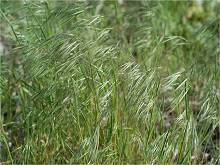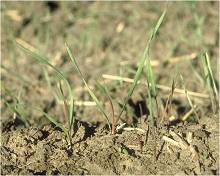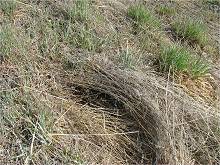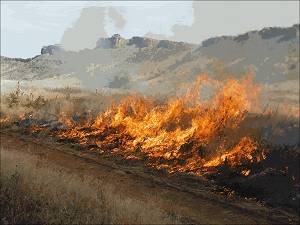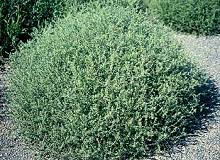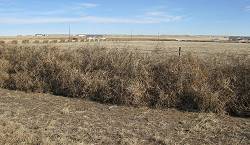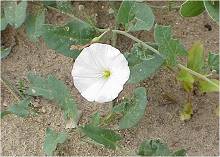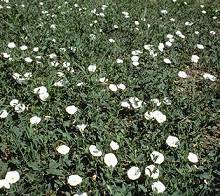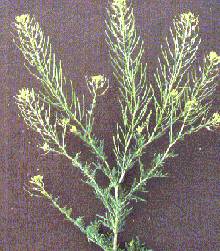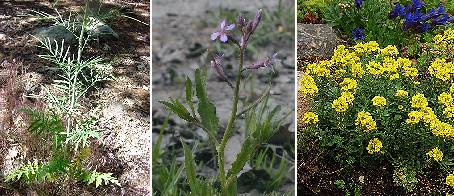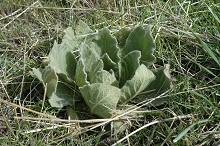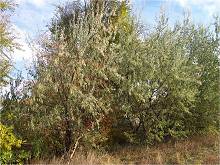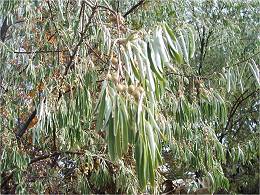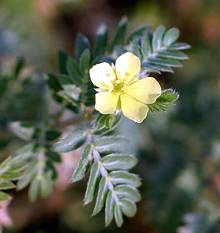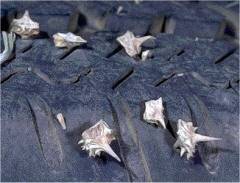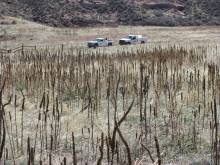The term 'cheatgrass' is often used to describe various annual brome species. Locally, cheatgrass refers to downy brome and Japanese brome collectively, both species found throughout Larimer County below 9,000 feet. Downy brome is the more prominent of the two grasses. Cheatgrass species follow a winter annual life cycle - seed germinates following late summer or early fall moisture (some spring emergence can occur as well), becomes dormant in winter, and is the first grass to green-up in the spring. Cheatgrass typically sets seed in May and dries down by July. At maturity, the abundant and very prickly seed heads become a nuisance to hikers, pets and livestock. Dense stands of dry plant material create a fine-fuel source for frequent summer wildfires in the western United States.
The most common herbicide for controlling cheatgrass is imazapic (Plateau/Panoramic). Treatments should be applied in the fall either pre-emergent or early post emergent (prior to the tillering stage of the grass). Glyphosate (Roundup and others) can be applied at low rates in the winter when perennial grasses are dormant for selective control. On-going research has found that Matrix has shown effective control with the advantage of working beyond the tillering stage, making the timing of use of Matrix less essential than imazapic.
No insect biocontrol agents are available for control of cheatgrass. Grazing in the early spring when the grass is palatable can suppress seed head production, but can also be injurious to desirable perennial grasses at that time.
Hand pulling or tillage (where feasible) is effective if conducted prior to seed set. Mowing is marginally effective, as re-growth will occur and plants will set seed from a reduced height.
Fire can be an effective tool for cheatgrass management if conducted at the right time. A prescribed burn in the late fall or early spring is least injurious to desirable perennial grasses that are dormant at those times. The goal of a prescribed burn is to generate enough heat from burning the previous season's plant residue to scorch the newly-emerged green seedling cheatgrass. If the fire burns too quickly, or the available fuel is insufficient to burn hot enough, the low-lying cheatgrass seedlings will escape. Cheatgrass proliferates following summer wildfires that eliminate desirable plants and create openings for cheatgrass emergence with late summer rains. Also, fire removes the thatch layer that can disrupt an herbicide's effectiveness.
Kochia
and Russian thistle are the most common annual weeds on roadsides, pasture and farmland of eastern Colorado. These two members of the chenopodiaceae, or goosefoot family, typically germinate in March and April, then flower and set seed from July to October. At maturity these plants break off at the base and become tumbleweeds. Kochia and Russian thistle are often the first weeds to appear on disturbed sites and areas with high soil nitrate content around corrals and barns. Both plants are prolific seed producers, with seed that remains viable in the soil for 2-3 years.
The most effective herbicides for controlling kochia are dicamba (Banvel, Vanquish, Clarity) and Vista. 2,4-D works best for controlling Russian thistle. For control of both species apply a combination of dicamba and 2,4-D. This pre-mix is available under numerous brand names such as Outlaw, Rangestar, Veteran 720, Weedmaster, and others.
No insect biocontrol agents are available for control of these 2 species. These plants are palatable to livestock when green and grazing can provide suppression, though not control.
Tillage or hand pulling is effective for controlling these annuals. Mowing is only a temporary solution, as kochia and Russian thistle will quickly re-grow, often in a stand more dense and uniform than prior to mowing.
Field bindweed is a low growing, deep-rooted perennial plant that reproduces by seed or underground rootstalks. Field bindweed is an extremely persistent plant though not very competitive if desirable vegetation can be established. Field bindweed seeds can remain viable in the soil for 50+ years.
The most effective herbicides for control of field bindweed are Tordon, Arsenal, Plateau, Paramount, dicamba, and 2,4-D.
For insect biocontrol, a gall mite Aceria malherbae, and to a lesser extent a defoliating moth, Tyta luctuosa are becoming well established in Colorado and having a significant effect on field bindweed infestations. The result of the insect feeding is a much less competitive stand of field bindweed with plants displaying curled leaves and reduced stolon growth.
Shallow tillage (disk, sweep) can be counter-productive, creating a denser, more uniform stand of field bindweed. Deeper tillage, if feasible, such as moldboard plowing can provide 1-2 years control.
These plants all display similar growth habits, site characteristics and responses to management methods. Annual mustards typically germinate in the fall, to a lesser extent in the spring, flower early in the spring and dry down by July. These species are quick to invade disturbed sites but are not competitive once perennial grasses are established.
The most effective herbicides for controlling annual mustards are Escort, Plateau/Panoramic, and Telar. Mustard species are frequently referenced in the herbicide guide because of this plant family's unique tolerance to numerous herbicides used for managing other noxious weeds.
No insect biocontrol agents are available for control of these species. Mustards are generally not palatable to livestock.
Hand pulling and digging are effective methods for control of annual plants.
Common mullein is a biennial plant commonly found in disturbed areas of range and pasture.
Common mullein seldom appears to have invasive characteristics except on heavily disturbed sites such as intensively grazed pastures, prairie dog colonies, or sites severely impacted by wildfire. Common mullein seed germinates in the late summer or fall producing a rosette with soft, velvet-like leaves. Yellow flowers grow from a tall, solitary stalk that appears in mid-summer.
The most effective herbicides for controlling common mullein are Escort, Milestone, and Telar when used with a good surfactant.
There are no insect biocontrol agents available for control of common mullein.
Hand pulling or digging this biennial is an effective method of control if the top 2-3 inches of tap root is removed.
A deciduous shrub or small tree that was introduced into this country for erosion control, windbreaks and as an ornamental tree. Russian olive is a phreatophyte, or water-loving plant that has become an invasive species along rivers, irrigation ditches, reservoirs, and other riparian habitats. These thorny trees form dense, impenetrable thickets on many river bottoms, and eventually crowd out native cottonwood trees and willows. Russian olives produce large numbers of white berries, or seed that is consumed by birds and spread from site to site when passed through their systems undigested. Because of this, suburban backyard trees can serve as a seed source for spread of Russian olives to natural areas located miles away.
Numerous herbicides can provide control of Russian olives, the choice depends on size of the trees and proximity to water or other desirable vegetation. Large trees are commonly removed by cutting down at the base and applying an herbicide to the stump to prevent re-sprouting. A methylated seed oil plus Garlon, Arsenal or Roundup is frequently used for cut-stump treatments. Smaller trees can be controlled with a foliar application of Arsenal, or if near water, Habitat (same active ingredient with an aquatic label.) No insect biocontrol agents are available for control of Russian olive.
Mechanical treatments such as cutting, bulldozing, and fire are temporarily effective for controlling Russian olives, but re-sprouting is a problem that requires an herbicide application to prevent subsequent treatments the following season.
Also known as 'goathead', this annual forb produces yellow flowers and grows in mats that can spread to 4 feet in diameter. Puncturevine appears throughout spring and summer in multiple flushes following significant rainfall. The plants reproduce from seed that is contained within a very spiny bur that gives this weed the name 'goathead'. The burs are sharp enough to puncture bicycle tires and make life miserable for barefoot hikers.
Numerous selective herbicides (won't injure grasses) are effective for controlling puncturevine, the problem with managing this persistent weed is staying after multiple flushes that occur during the growing season. Dicamba (Banvel, Vanquish, Clarity), 2,4-D, and Vista effectively control emerged puncturevine. For soil residual activity, Telar and Tordon provide season-long control.
Insect biocontrol agents are available that feed on the seed heads and stems of puncturevine, and provide effective management in some areas. Unfortunately, these weevils are not effective under Colorado's cold climatic conditions.
Digging and pulling provide effective control of annual weeds such as puncturevine. If plants have set seed, plant material should be bagged and disposed of to prevent seed dispersal.
